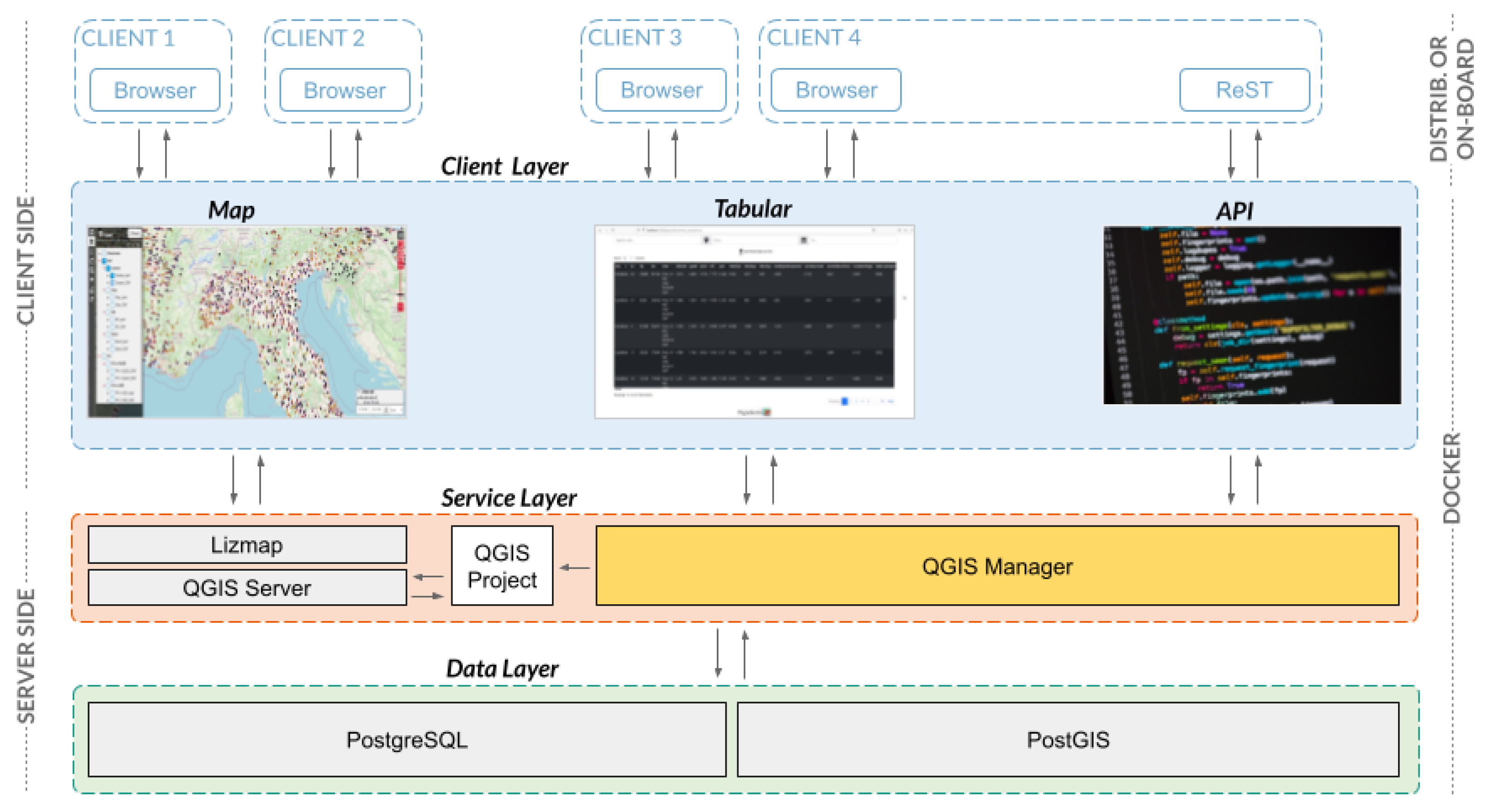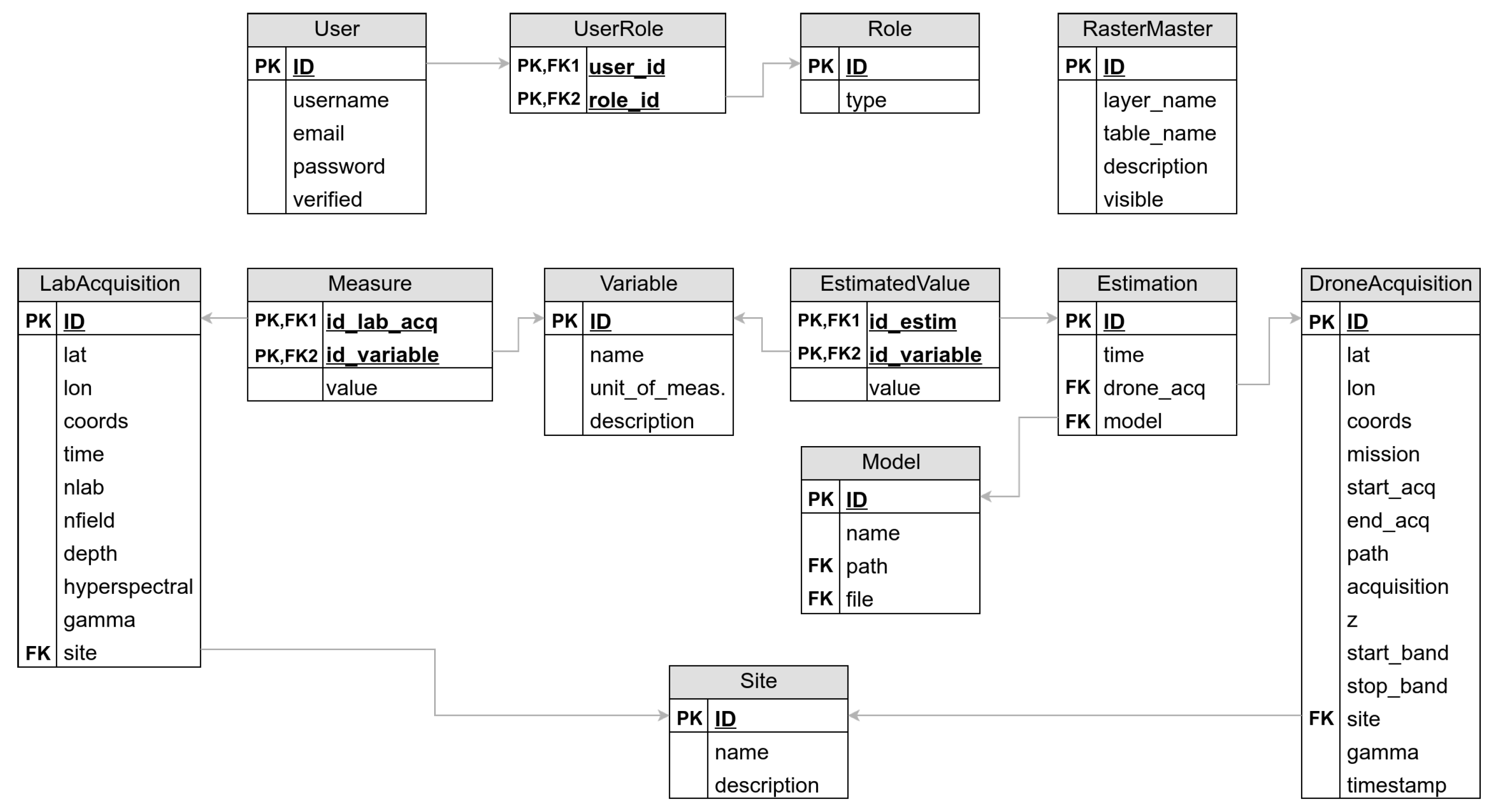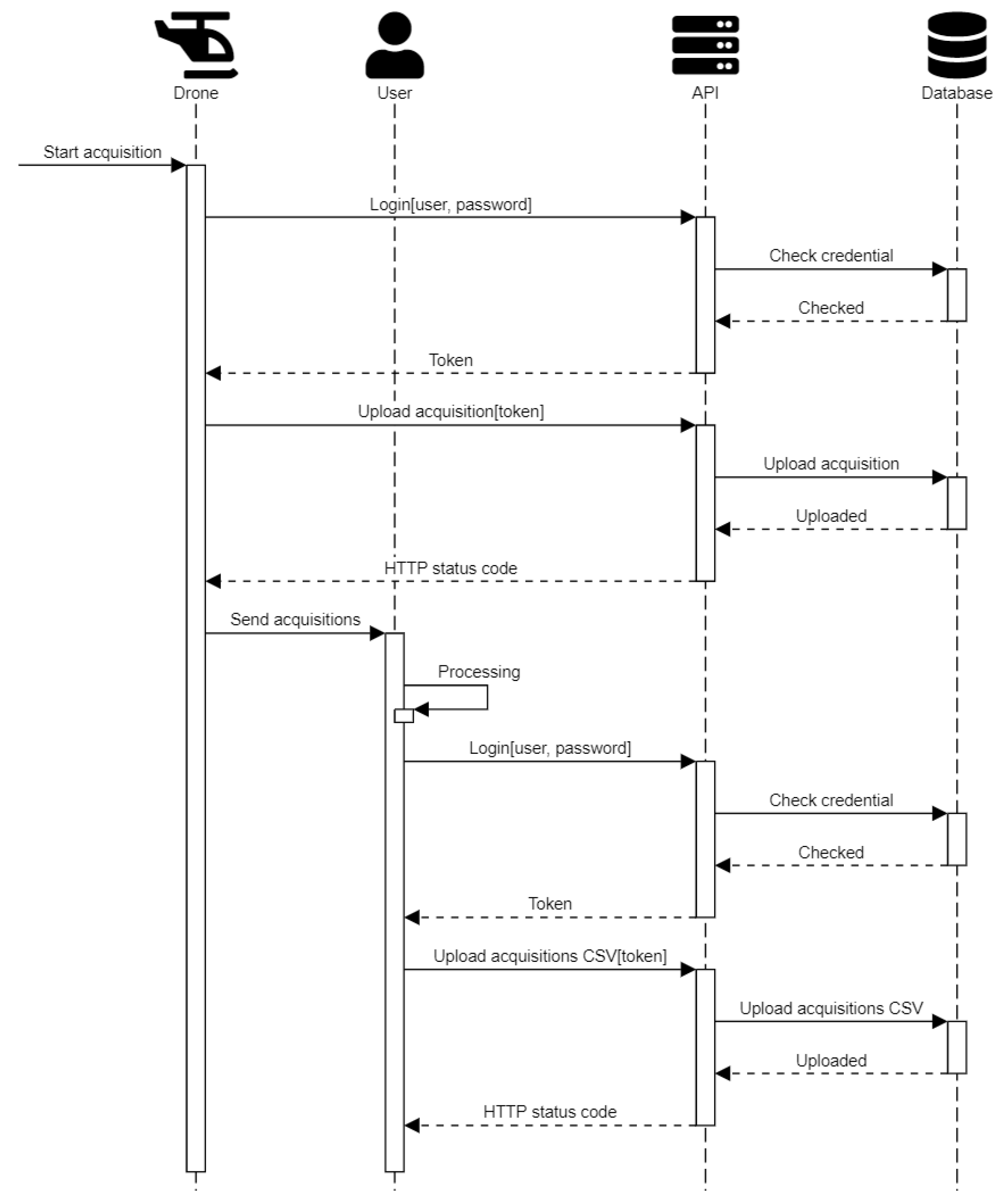An Open-Source Platform for GIS Data Management and Analytics
Abstract
1. Introduction
- Supports data collection and management from heterogeneous data sources;
- Provides all the tools for data visualization and decision making;
- Provides soil characteristics AI-based predictors;
- Provides a procedure to include custom predictors.
2. Scientific and Technological Context
3. Proposed Platform
3.1. Overview
3.2. Platform Database
3.3. The Map Component
3.4. The Tabular Component
3.5. API
4. Use Case
5. Experimental Results
Software Availability
6. Discussion
- Focus: FREEWAT [33] has been designed for managing ground- and surface-water resources. The focus is then applied to modeling the water flow through hydrological models. GeoAPEXOL [34] has been crafted with the goal of evaluating nonpoint source pollution (NPS), e.g., pollution coming from contaminants that end up on the ground or from human activity. To this aim, the platform offers several field and small watershed simulations for predicting NPS. Crop-CASMA [35] has been created for studying biodiversity through remote sensing. It contains remotely sensed geospatial soil moisture and vegetation index data. DIVA-GIS [36] is a generic tool for the creation of maps. The proposed method differs from state-of-art methods as it proposes several tools for supporting the manual annotation of ground points (e.g., tabular, map-based, and csv-based). It also allows the creation of digital soil maps and second-level analyses. To prove its effectiveness, the proposed platform has been used to collect and analyze a library of soil properties relative to the Lombardy region in Italy.
- End-user type: The definition and development of user processes in a GIS-based platform is guided by the skills expected of the end user. In this context, FREEWAT [33], GeoAPEXOL [34], and Crop-CASMA [35] are intended for experienced users, such as researchers. DIVA-GIS [36] and the proposed platform are designed for both expert and non-expert users. In the case of the Pignoletto platform, this is also possible due to the fact that the platform is data-agnostic, that is, the ground-points to be inspected can represent any kind of data or information.
- Technological context: The technology used in the development of a platform influences its reach and spread. FREEWAT [33] is a QGIS plugin. This limits its effectiveness only to QGIS users. DIVA-GIS [36] has been developed for Windows and Mac OSX only. In addition, the tool is becoming obsolete as the last update was performed in 2011. GeoAPEXOL [34], Crop-CASMA [35], and the proposed platform are delivered through a web page, allowing their use on any platform through a web browser.
- Integrability: Platforms can be closed stand-alone products, or they can allow the exposition of the data gathered and inferred through the offered functionalities. FREEWAT [33] is fully integrated in QGIS, and thus, its interoperability is granted by the QGIS environment. DIVA-GIS [36] and GeoAPEXOL [34] are closed environments that do not allow a direct data exposition. Crop-CASMA [35] and the proposed platform implement the GIS WMS standard. This allows the exposition and the direct integration of the data under analysis in other GIS-based platforms. In this conception, the proposed platform can become a data collection and inspection module in a broader pipeline.
7. Conclusions
Author Contributions
Funding
Institutional Review Board Statement
Informed Consent Statement
Data Availability Statement
Conflicts of Interest
Appendix A
Questions of Task-Driven Assessment
| Map | Display the acquisitions relative to the Argilla variable under the group lab_acquisition. Zoom on a point and click on it to view its value. How hard is this task? |
| Open the tabular visualization (“Dati” tool on the left sidebar) and click on the button relative to the Argilla acquisitions to open the table. Locate the sample DL-06 in the table and click the lens icon to view the corresponding point on the map. Click on the found point to view the relative info on the left panel. | |
| Zoom out to have all the acquisitions (points) on the screen visible. Search all the samples that contain a level of Argilla between 200 and 400 (use the “Filtro” tool on the left sidebar). | |
| Display the raster slope (it can take some time to load). | |
| Tabular | Download the dataset about Laboratory acquisition. |
| Filter the samples that have been acquired in Lodi. | |
| Sort the “sito” column on the Laboratory acquisitions in descending order. | |
| Go to the Drone acquisition page and try to filter the samples that have been acquired from 5 April 2022 to 14 May 2022. | |
| General | How user-friendly is Pignoletto platform map interface? |
| How user-friendly is Pignoletto platform tabular interface? | |
| Do you think this application can provide valuable support for precision agriculture? |
References
- Velten, S.; Leventon, J.; Jager, N.; Newig, J. What is sustainable agriculture? A systematic review. Sustainability 2015, 7, 7833–7865. [Google Scholar] [CrossRef]
- Pierce, F.J.; Nowak, P. Aspects of precision agriculture. Adv. Agron. 1999, 67, 1–85. [Google Scholar]
- Cammarano, D. Precision Agriculture an International Journal on Advances in Precision Agriculture. 2023. Available online: https://www.springer.com/journal/11119 (accessed on 23 March 2023).
- Granell, C.; Kamilaris, A.; Kotsev, A.; Ostermann, F.O.; Trilles, S. Internet of things. In Manual of Digital Earth; Springer: Berlin/Heidelberg, Germany, 2020; pp. 387–423. [Google Scholar]
- Trilles, S.; González-Pérez, A.; Huerta, J. An IoT platform based on microservices and serverless paradigms for smart farming purposes. Sensors 2020, 20, 2418. [Google Scholar] [CrossRef]
- Trilles, S.; Torres-Sospedra, J.; Belmonte, Ó.; Zarazaga-Soria, F.J.; González-Pérez, A.; Huerta, J. Development of an open sensorized platform in a smart agriculture context: A vineyard support system for monitoring mildew disease. Sustain. Comput. Inform. Syst. 2020, 28, 100309. [Google Scholar] [CrossRef]
- Trilles, S.; González-Pérez, A.; Huerta, J. A comprehensive IoT node proposal using open hardware. A smart farming use case to monitor vineyards. Electronics 2018, 7, 419. [Google Scholar] [CrossRef]
- Lindblom, J.; Lundström, C.; Ljung, M.; Jonsson, A. Promoting sustainable intensification in precision agriculture: Review of decision support systems development and strategies. Precis. Agric. 2017, 18, 309–331. [Google Scholar] [CrossRef]
- Shafi, U.; Mumtaz, R.; García-Nieto, J.; Hassan, S.A.; Zaidi, S.A.R.; Iqbal, N. Precision agriculture techniques and practices: From considerations to applications. Sensors 2019, 19, 3796. [Google Scholar] [CrossRef]
- Ayaz, M.; Ammad-Uddin, M.; Sharif, Z.; Mansour, A.; Aggoune, E.H.M. Internet-of-Things (IoT)-based smart agriculture: Toward making the fields talk. IEEE Access 2019, 7, 129551–129583. [Google Scholar] [CrossRef]
- Sishodia, R.P.; Ray, R.L.; Singh, S.K. Applications of remote sensing in precision agriculture: A review. Remote Sens. 2020, 12, 3136. [Google Scholar] [CrossRef]
- Tantalaki, N.; Souravlas, S.; Roumeliotis, M. Data-driven decision making in precision agriculture: The rise of big data in agricultural systems. J. Agric. Food Inf. 2019, 20, 344–380. [Google Scholar] [CrossRef]
- Linaza, M.T.; Posada, J.; Bund, J.; Eisert, P.; Quartulli, M.; Döllner, J.; Pagani, A.; G Olaizola, I.; Barriguinha, A.; Moysiadis, T.; et al. Data-driven artificial intelligence applications for sustainable precision agriculture. Agronomy 2021, 11, 1227. [Google Scholar] [CrossRef]
- Mulla, D.J. Satellite Remote Sensing for Precision Agriculture. In Sensing Approaches for Precision Agriculture; Springer: Berlin/Heidelberg, Germany, 2021; pp. 19–57. [Google Scholar]
- Elijah, O.; Rahman, T.A.; Orikumhi, I.; Leow, C.Y.; Hindia, M.N. An overview of Internet of Things (IoT) and data analytics in agriculture: Benefits and challenges. IEEE Internet Things J. 2018, 5, 3758–3773. [Google Scholar] [CrossRef]
- Strickland, E. Andrew Ng, AI Minimalist: The Machine-Learning Pioneer Says Small is the New Big. IEEE Spectr. 2022, 59, 22–50. [Google Scholar] [CrossRef]
- Kukar, M.; Vračar, P.; Košir, D.; Pevec, D.; Bosnić, Z. AgroDSS: A decision support system for agriculture and farming. Comput. Electron. Agric. 2019, 161, 260–271. [Google Scholar]
- Coppola, E.; Moccia, F.D. LANDSUPPORT, a decision support system for territorial government. Upl.-J. Urban Plan. Landsc. Environ. Des. 2019, 4, 29–38. [Google Scholar]
- Valjarević, A.; Milanović, M.; Gultepe, I.; Filipović, D.; Lukić, T. Updated Trewartha climate classification with four climate change scenarios. Geogr. J. 2022, 188, 506–517. [Google Scholar] [CrossRef]
- Mathenge, M.; Sonneveld, B.G.; Broerse, J.E. Application of GIS in Agriculture in Promoting Evidence-Informed Decision Making for Improving Agriculture Sustainability: A Systematic Review. Sustainability 2022, 14, 9974. [Google Scholar] [CrossRef]
- Longley, P.A.; Goodchild, M.F.; Maguire, D.J.; Rhind, D.W. Geographic Information Systems and Science; John Wiley & Sons: Hoboken, NJ, USA, 2005. [Google Scholar]
- QGIS Development Team. QGIS Geographic Information System; QGIS Association: Grüt, Switzerland, 2022. [Google Scholar]
- Booth, B.; Mitchell, A. Getting Started with ArcGIS; ESRI: Redlands, CA, USA, 2001. [Google Scholar]
- Sebastianelli, A.; Del Rosso, M.P.; Ullo, S.L. Automatic dataset builder for Machine Learning applications to satellite imagery. SoftwareX 2021, 15, 100739. [Google Scholar] [CrossRef]
- Ma, Z.; Hart, M.M.; Redmond, R.L. Mapping vegetation across large geographic areas: Integration of remote sensing and GIS to classify multisource data. Photogramm. Eng. Remote Sens. 2001, 67, 295–308. [Google Scholar]
- Michelon, G.K.; Bazzi, C.L.; Upadhyaya, S.; de Souza, E.G.; Magalhães, P.S.G.; Borges, L.F.; Schenatto, K.; Sobjak, R.; Gavioli, A.; Betzek, N.M. Software AgDataBox-Map to precision agriculture management. SoftwareX 2019, 10, 100320. [Google Scholar] [CrossRef]
- Bazzi, C.L.; Jasse, E.P.; Magalhães, P.S.G.; Michelon, G.K.; de Souza, E.G.; Schenatto, K.; Sobjak, R. AgDataBox API–Integration of data and software in precision agriculture. SoftwareX 2019, 10, 100327. [Google Scholar] [CrossRef]
- Frigerio, I.; Ventura, S.; Strigaro, D.; Mattavelli, M.; De Amicis, M.; Mugnano, S.; Boffi, M. A GIS-based approach to identify the spatial variability of social vulnerability to seismic hazard in Italy. Appl. Geogr. 2016, 74, 12–22. [Google Scholar] [CrossRef]
- Petito, M.; Cantalamessa, S.; Pagnani, G.; Degiorgio, F.; Parisse, B.; Pisante, M. Impact of Conservation Agriculture on Soil Erosion in the Annual Cropland of the Apulia Region (Southern Italy) Based on the RUSLE-GIS-GEE Framework. Agronomy 2022, 12, 281. [Google Scholar] [CrossRef]
- Blanco, I.; Loisi, R.V.; Sica, C.; Schettini, E.; Vox, G. Agricultural plastic waste mapping using GIS. A case study in Italy. Resour. Conserv. Recycl. 2018, 137, 229–242. [Google Scholar] [CrossRef]
- Mancini, F.; Ceppi, C.; Ritrovato, G. GIS and statistical analysis for landslide susceptibility mapping in the Daunia area, Italy. Nat. Hazards Earth Syst. Sci. 2010, 10, 1851–1864. [Google Scholar] [CrossRef]
- Ladisa, G.; Todorovic, M.; Liuzzi, G.T. A GIS-based approach for desertification risk assessment in Apulia region, SE Italy. Phys. Chem. Earth Parts A/B/C 2012, 49, 103–113. [Google Scholar] [CrossRef]
- Rossetto, R.; De Filippis, G.; Borsi, I.; Foglia, L.; Cannata, M.; Criollo, R.; Vázquez-Suñé, E. Integrating free and open source tools and distributed modelling codes in GIS environment for data-based groundwater management. Environ. Model. Softw. 2018, 107, 210–230. [Google Scholar] [CrossRef]
- Feng, Q.; Flanagan, D.C.; Engel, B.A.; Yang, L.; Chen, L. GeoAPEXOL, a web GIS interface for the Agricultural Policy Environmental eXtender (APEX) model enabling both field and small watershed simulation. Environ. Model. Softw. 2020, 123, 104569. [Google Scholar] [CrossRef]
- Zhang, C.; Yang, Z.; Zhao, H.; Sun, Z.; Di, L.; Bindlish, R.; Liu, P.W.; Colliander, A.; Mueller, R.; Crow, W.; et al. Crop-CASMA: A web geoprocessing and map service based architecture and implementation for serving soil moisture and crop vegetation condition data over US Cropland. Int. J. Appl. Earth Obs. Geoinf. 2022, 112, 102902. [Google Scholar] [CrossRef]
- Hijmans, R.J.; Guarino, L.; Cruz, M.; Rojas, E. Computer tools for spatial analysis of plant genetic resources data: 1. DIVA-GIS. In Plant Genetic Resources Newsletter; Alliance of Bioversity International and CIAT: Rome, Italy, 2001; pp. 15–19. [Google Scholar]
- Laurent, J.B.; Leroux, L. Online publication of a land cover map using LizMap. QGIS Generic Tools 2018, 1, 243–255. [Google Scholar]
- Michaelis, C.D.; Ames, D.P. Web Feature Service (WFS) and Web Map Service (WMS); Encyclopedia of GIS; Springer: Boston, MA, USA, 2008. [Google Scholar]
- OpenStreetMap Contributors. 2017. Available online: https://www.openstreetmap.org (accessed on 6 March 2023).
- Brooke, J. Sus: A quick and dirty usability scale. Usability Eval. Ind. 1996, 189, 4–7. [Google Scholar]
- Anderson, C. Docker [software engineering]. IEEE Softw. 2015, 32, 102-c3. [Google Scholar] [CrossRef]







 | Home: brings the user back to the project selection page. |
 | Layers: to control the visibility of the layers on the map |
 | Information: gives information about the project |
 | Filter: lets the user filter data based on their properties. |
 | WPS: for choosing a model (or algorithm) uploaded and extract useful informations. |
 | Popup: it will show information about the data clicked by the user. |
 | Selection: enables the drawing on the map. |
 | Tooltip: It will highlight data of the layer under inspection that lies under the cursor. |
 | Permalink: enables the sharing of the link. |
 | Data: shows informations about collected data in a tabular way. |
 | WPSResults: shows the results of the algorithms used. |
| Attribute | Value |
|---|---|
| Name of the proposed software | Pignoletto platform |
| Availability | https://github.com/SimoLoca/Pignoletto_platform, accessed on 6 March 2023 |
| Developers | Locatelli, Piccoli, Napoletano, Schettini |
| Contact | flavio.piccoli@unimib.it |
| Licence | MIT License |
| Hardware required | 2+ GHz processor. 4+ GB of RAM |
| Software required | Python 3.x, Docker |
| Program Language | Python 3.x |
| Program size | 26.3 MB |
Disclaimer/Publisher’s Note: The statements, opinions and data contained in all publications are solely those of the individual author(s) and contributor(s) and not of MDPI and/or the editor(s). MDPI and/or the editor(s) disclaim responsibility for any injury to people or property resulting from any ideas, methods, instructions or products referred to in the content. |
© 2023 by the authors. Licensee MDPI, Basel, Switzerland. This article is an open access article distributed under the terms and conditions of the Creative Commons Attribution (CC BY) license (https://creativecommons.org/licenses/by/4.0/).
Share and Cite
Piccoli, F.; Locatelli, S.G.; Schettini, R.; Napoletano, P. An Open-Source Platform for GIS Data Management and Analytics. Sensors 2023, 23, 3788. https://doi.org/10.3390/s23083788
Piccoli F, Locatelli SG, Schettini R, Napoletano P. An Open-Source Platform for GIS Data Management and Analytics. Sensors. 2023; 23(8):3788. https://doi.org/10.3390/s23083788
Chicago/Turabian StylePiccoli, Flavio, Simone Giuseppe Locatelli, Raimondo Schettini, and Paolo Napoletano. 2023. "An Open-Source Platform for GIS Data Management and Analytics" Sensors 23, no. 8: 3788. https://doi.org/10.3390/s23083788
APA StylePiccoli, F., Locatelli, S. G., Schettini, R., & Napoletano, P. (2023). An Open-Source Platform for GIS Data Management and Analytics. Sensors, 23(8), 3788. https://doi.org/10.3390/s23083788









